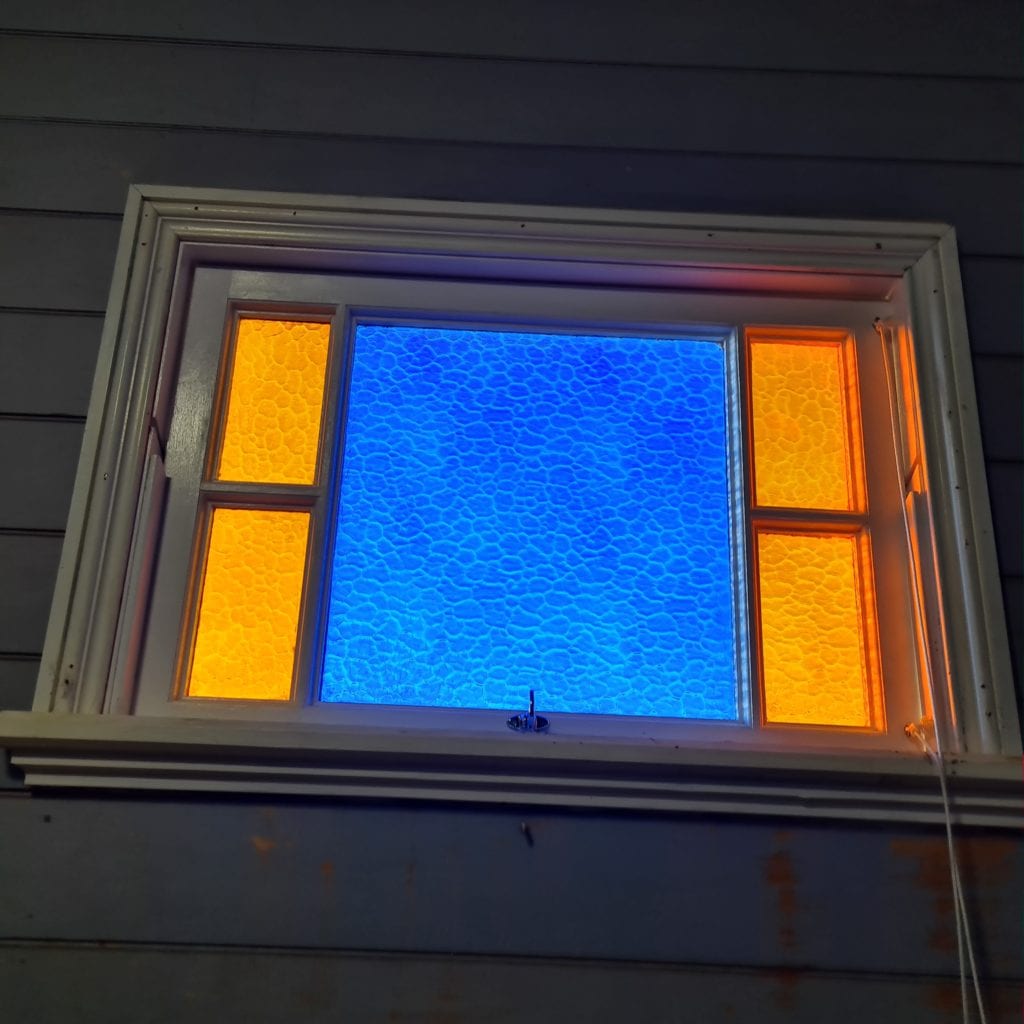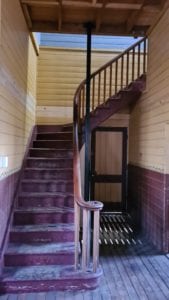A Masonic Lodge, home of the Comet Lodge of Freemasons, has been part of Barcaldine’s history since its earliest days. The (second) unique building, built in 1900 and dedicated in 1901, stands today on the site of the original building that arrived in Barcaldine in 1886. Conservation work was undertaken on the building in the early 1980s, when the painted ‘masonry’ effect on the facade was reinstated.
The main buildings of embryonic Barcaldine were made at various termini of the advancing railway. Some moved four or five times before coming to rest 358 miles west of Rockhampton. One of these was the Masonic temple, a two storey corrugated iron building.
Comet Lodge of Freemasons was formed at Dingo Creek in 1876 by Robert Ballard, chief railway engineer; Willoughby Hannam, railway surveyor; and George Shakspeare of Barcaldine hotel and racing fame. It moved to Cometville in 1878, Emerald 1879, Bogantungan 1881, Pine Hill 1883, Jericho 1885 and finally to Barcaldine in 1886.
 After so many relocations, it was a bit worn out so members decided to replace it in 1900 with a new temple.
After so many relocations, it was a bit worn out so members decided to replace it in 1900 with a new temple.
The new building was completed in 1901, and modelled exactly on the original – two-storied and iron clad with a remarkable imitation-stone front wall. The sides and back were left unadorned, but the highly decorated front was painted to make it appear as if the building was made of stone blocks, and adorned with pilasters (attached columns), friezes, semi circular windows and a porch. The decorators used three colours of paint, applied to chamferboard, to make the building appear as if it was made of stone.
The interior of the building is decorated with a stencilled frieze on the ground floor, and an upper room with a curved ceiling and panelled linings and mouldings in tongue and groove boards.

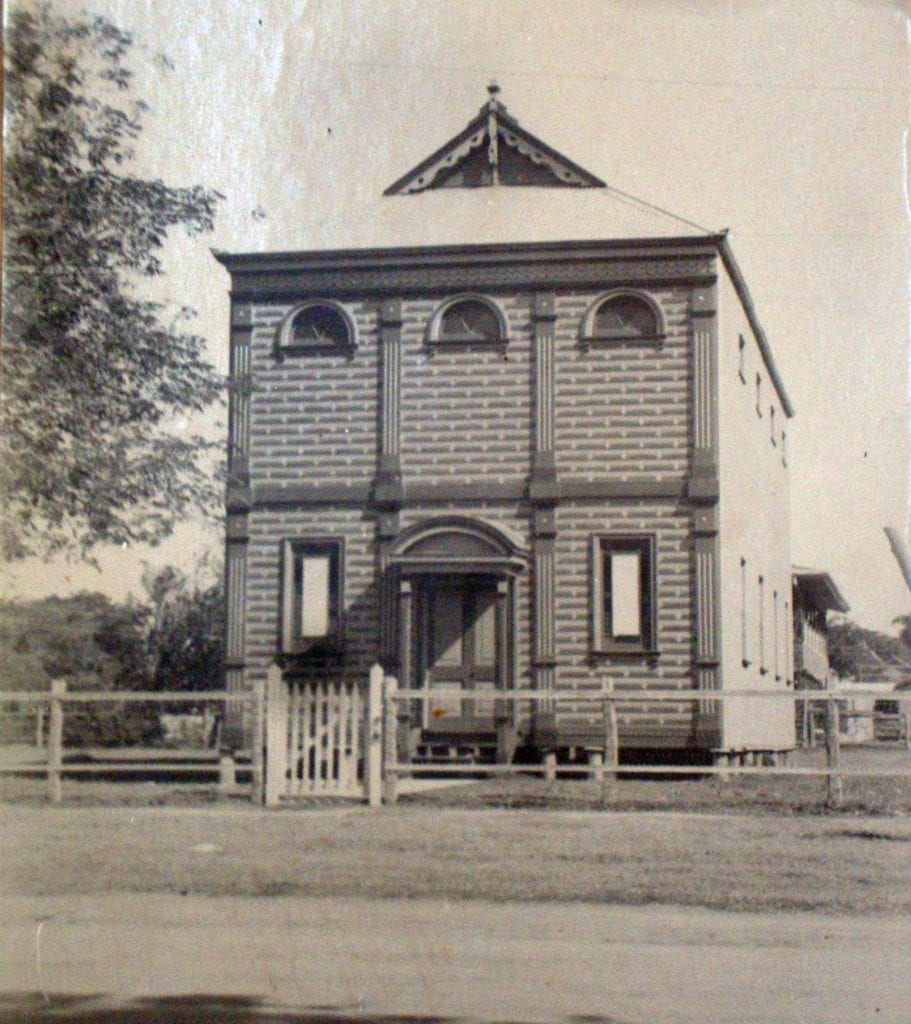
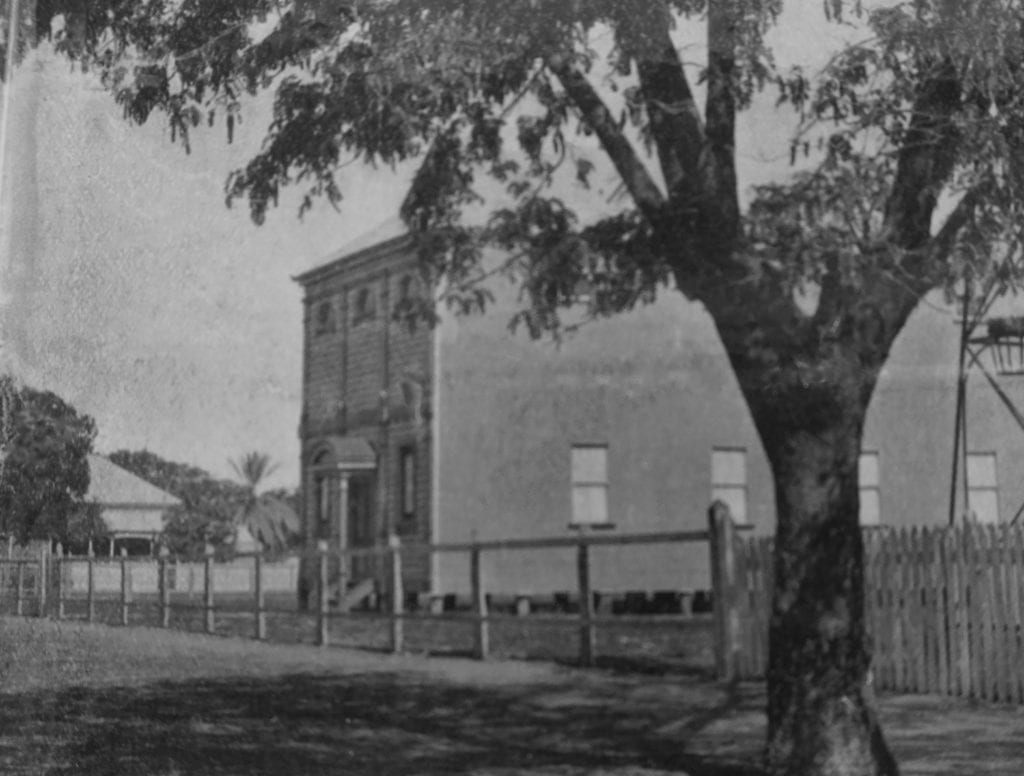
The Lodge celebrated its Jubilee in 1927, reported in the Western Champion, 12 February 1927:
A Masonic Jubilee.
Comet Lodge, Barcaldine—1877-1927
The Master of the “Comet” Lodge, Bro. O. P. Halvorsen, was singularly fortunate on the occasion of his taking the chair after the usual summer recess, in presiding over a special Jubilee Lodge meeting, held in the Masonic Hall, Barcaldine, on Saturday, 30th January, the actual eve of the Jubilee. There was a very large number of brethren and visitors present, and the tables downstairs looked very pretty and appetising. A very unique exhibit on a side table was an arrangement of Masonic relics of the old days, including the original Wardens’ candlesticks loaned from the “Western Champion” Museum, copies of old documents, jewels, &c., some of priceless Masonic value nowadays. Bro. Tyler J. H. Kahl had arranged this. The proceedings in the Lodgeroom were interesting. Special hymns and music had been arranged, and these Included “Oh God our Help in Ages Past,” “Hear us Heavenly Father,” “Behold how good and joyful a thing it is, brethren to dwell together in unity,” and “Abide With Me.” Rt. Wor. J. Meacham P.G.W., delivered the oration on the history of the lodge, compiled by himself from the minute books. The following epitome will be read with interest by all Freemasons throughout the district: — The lodge was founded on January 80th, 1877; parent lodge, Leichhardt, No- 932-E.C.
Foundation members: Robert Ballard, Willoughby Hannam, Murdo Morrison, Alexander Mackenzie, Joseph Swadling, Annesley W. Voysey, George Page Shakespeare, Stephenson Fountain, Emanuel Roberts, and Daniel Sutherland. All are believed to be dead with exception of Bro. Mackenzie.
The “Comet” Lodge, No. 1680 (now U.G.L.Q., No. 28) has had a career which is probably unique in the records of Freemasonry in this State. It holds its Warrant almost 400 miles distant from the town for which it was granted. It pulled down its Masonic Hall six times, and re-erected the same at the several towns which became the temporary termini of the Central Railway during the first nine years of its existence. The preliminary meeting for the formation of a Masonic lodge was held at Dingo Creek (88 mile C-Q-R-) on October 25th, 1876. Nine Brethren were present, the majority being members of Leichhardt Lodge, No. 932. Bro. Willoughby Hannam was appointed Chairman. The meeting decided to invite Bro. Robert Ballard (Chief Engineer of the Central Hallway) to be the first W.M. The Wardens Treasurer, and Secretary were appointed from the Brethren present.
The application for the Warrant was drawn up and signed forthwith, and a license to hold Instruction meetings was obtained. The Dispensation was received from the R.W.D.G.M. by the end of the year, and Bros. Ballard, Shakspeare, and Hannam offered to erect a hall on liberal terms for the Lodge. Their offer was accepted. The first meeting was held on January 30th, 1877, the new hall having been erected in the meantime. The first installation was held on March 8th. 1877.
Wor. W. B. Bones, as Deputy for R.W D G M., was in the Chair, and was assisted by Bro. Boyd, W. M., and several Brethren of the Leichhardt Lodge. The Lodge remained but a short time at Dingo Creek. The progress of the railway construction necessitated its removal, and on March 12th, 1878, the first meeting was held at Cometville. There it remained for 18 months, and was then removed to Emerald, and opened there on November 25th, 1879. After a halt of two years it was again removed and opened at Bogantungan on November 8th, 1881. Another two years, and a move was made for Pine Hill. The first meeting was held there on December 11th, 1883. Another twenty months, and the Lodge opened at Jericho, on August 25th, 1885. Within sixteen months afterwards it removed to Barcaldine. The first meeting was held in Bro. H. G. Eccles’ Store on December 7th, 1886, and the first regular meeting in the hall—which had been moved up in the meantime —on December 28th, 1886. The expense of continually pulling down and removing the hall and the purchase of land always kept the Lodge funds very low. However, when Barcaldine was reached it was felt the Lodge was here to stay; the building was considerably improved internally, the membership increased and the Brethren discussed the matter of enlarging the old hall and erecting a new one. The matter was deferred from time to time owing to the periods of drought and consequent financial depression, but in 1900, when Bro. McCullough took the Chair for the second time, the matter was again brought forward. The Brethren were circularised to take up debentures, and a liberal response enabled the building committee to let the contract for a new hall at a cost of £720. The plans were presented to the Lodge by Bro. C. Dyer P.M. The first block was laid at the north-east corner by the W. M. in the presence of the Officers and several P.M.’s of the Lodge on November 39th, 1900, the Officers’ Roll and several Masonic records being deposited in the block in a sealed tube, and on February 28th, 1901, it was dedicated by the late R.W.D.G.M. Sir A. C. Gregory in the presence of a large assemblage of Brethren from Lodges in the West Central District. Since then the Lodge has made steady progress. It has retired its debentures, and has also assisted needy Brethren, and several charitable objects so far as its funds would permit. Amongst those who rendered good service to the Lodge from its foundation, financially and otherwise, is Wor. Geo. Page Shakspeare, and in recognition of his services he was made a life member; the only other Brother who has been on the roll forty years, and is still a subscribing member is Wor. William Henry James. Bro. William Allan was Tyler for twenty years. Rt. Wor. Bro. J. Meacham held the office of Secretary for eighteen years. The Lodge is responsible for the establishment of Lodges at Aramac, Blackall, Longreach, Springsure and Alpha, and indirectly in other places.
At the subsequent banquet, after the usual formal toasts, Bro. H. W. Griffin, handled the toast “Our First Jubilee” in a masterly fashion. This was responded to by Wor. Bro. E. A. Peel and Rt. Wor. Bro. C. J. James, who are the only remaining resident members of the old railway days regime, Bro. Peel having occupied the Master’s Chair in 1891-2, and Bro. James in 1893. Bro. Peel was very happy in his relation of old reminiscences, while Bro. James confined himself to the progress of the musical ceremonies of the lodge, tracing it from the days of 1891. Rt. Wor. J. Meacham became a member in 1891, and realising the great possibilities of the introduction of ample music in the lodge, collaborated with Bro. James, until to-day the musical ceremonies are perfect, and the lodge enjoys the distinction of having separate books of Odes for the ordinary work of the lodge, and for Installation. Rt. Wor. Bro. J. Meacham proposed “Foundation Members,” “Daughter Lodges and Visitors” by Wor. Bro. Bennett, and the Tyler’s Toast (Bro. J. H. Kahl) brought a very pleasant evening to a close at 12.15 with the singing of ”Auld Lang Syne” and the National Anthem.
Description
The hall is clad with horizontal timber boards painted to mimic ashlar masonry. The gable facing the front has scalloped barge boards and finials. The facade is divided into three bays by fluted timber pilasters supporting a scalloped entablature below the eave. It has a central entrance sheltered by a pediment porch and flanked by sash windows. The upper storey has high round arched windows to each bay. The sides of the building have large windows on the ground floor and small high openings on the floor above.
The interior is clad with tongue and groove timber boards and is very intact, retaining the original colour schemes. The ground floor, which is used as a supper room, exhibits a brown dado with hand painted floral frieze. Above this is are horizontal tongue and groove boards painted ochre yellow. The room has a series of shallow arched enclosed beams supporting the upper floor. At the rear of the ground floor there are ancillary rooms situated in either corner. Between them is a central entrance which has a section of hit and miss flooring, presumably for the clearing of mud from boots.
From here a timber stair with a simple slatted balustrade rises in an L form to the upper floor landing off which a dressing room opens directly into the lodge room. This has partially curved ceilings that rise to a boarded ceiling set between moulded ribs which spring from mock pilasters at the side walls. The ceiling between has been lined with what appears to be ‘caneite’ sheet. The wall panels are a mix of horizontal and diagonal boards set above a simple dado. It is lit only by small high windows down the sides and by the three semicircular windows at the front.
Source: Queensland Heritage Register
Interior
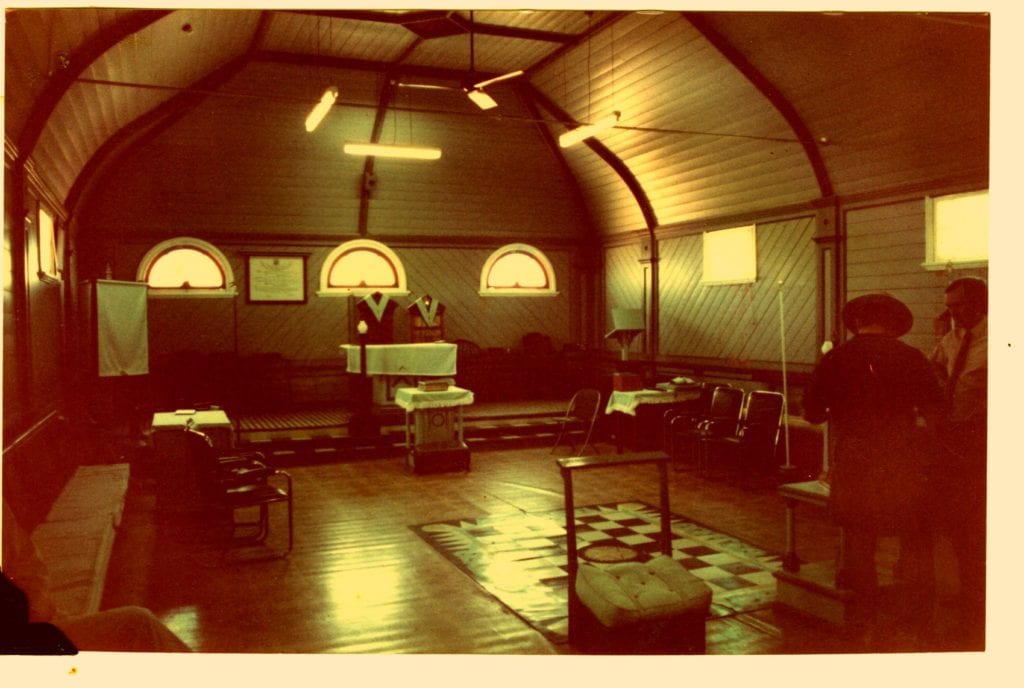
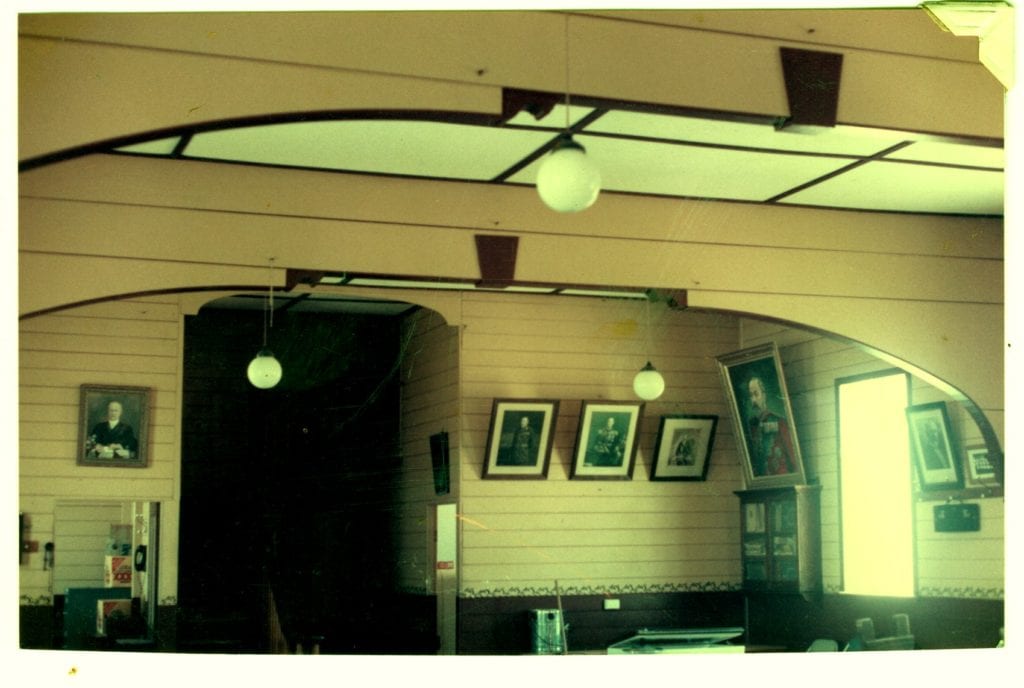
Exterior


Restoration
By 1980, the imitation stone exterior paintwork was in very poor condition. The Lodge was considering covering the building with aluminium cladding to solve the problem. Money made available through the National Trust provided the opportunity to restore the building. So i 1980 and 1984 the building was restored by National Trust funds.
Conservation architect Peter Marquis-Kyle used old photographs to discover the original appearance of the building and took paint scrapings to determine the original paint colours. Broken pieces of timber were repaired and the whole front carefully restored and repainted in the original colours.
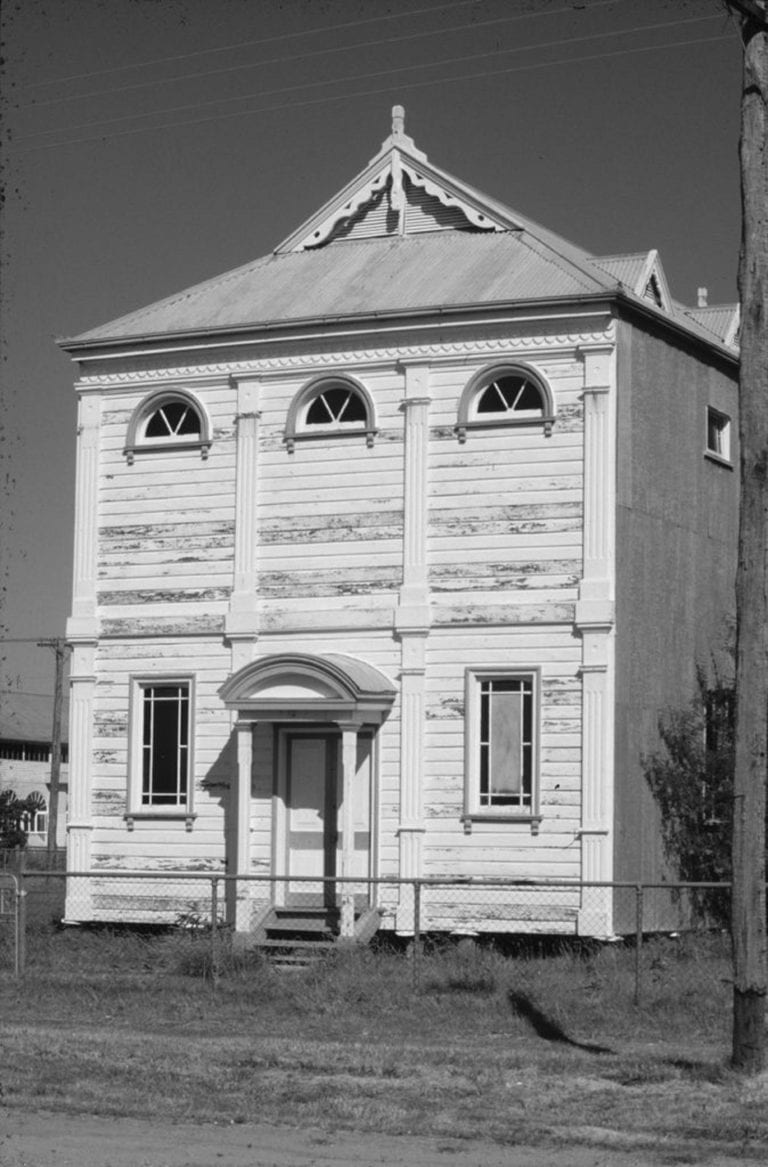
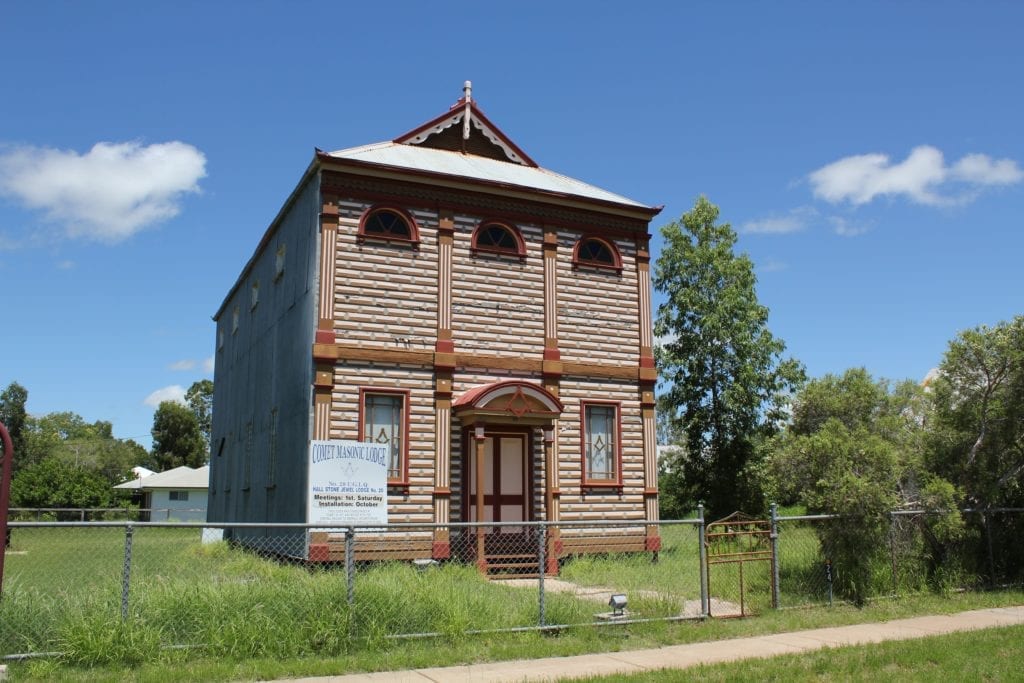
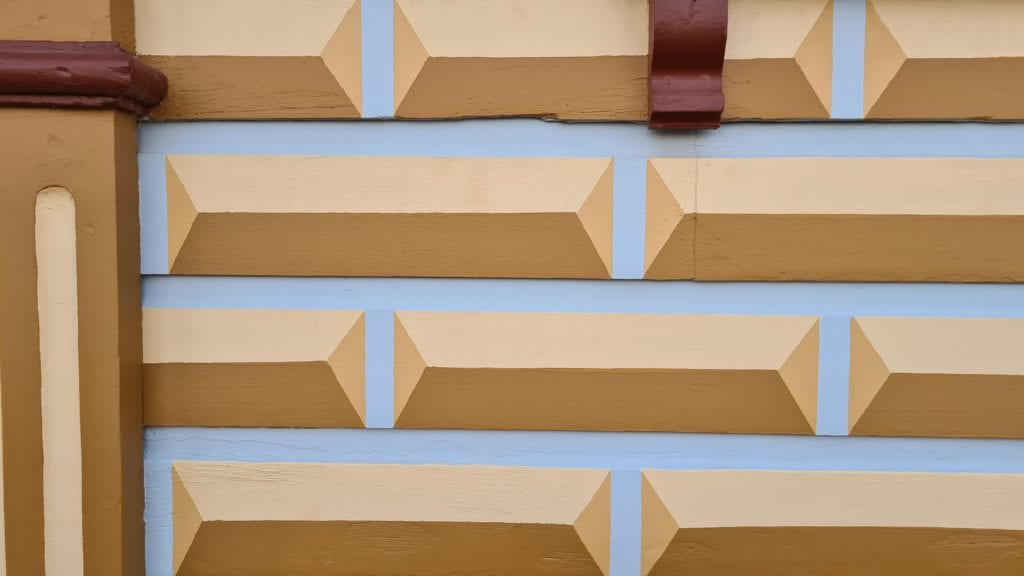
Story about women and the Lodge
The Masonic Lodge was off limits to women – unless they were doing the cleaning so the story goes.
The first female associate member was the wife of one of the members. The story goes that she wanted to know what went on in the meetings of the all-male Lodge members – a secretive society in those days. So one day she decided to hide under the long tablecloth in the upstairs meeting room after she finished cleaning to listen into the meeting. But at some point she sneezed, giving herself away. The men apparently decided to solve the problem of a woman knowing what occurred at their secret meetings by accepting her as an associate member, meaning she had to swear an oath of secrecy. There’s probably more to that story, but many thanks to the late Bill Scott, local historian for his recollection of the ‘incident’. Kev Kerr tells me the story appears to do the rounds of many lodges.
I was therefore able to enter the building myself recently when I was shown the interior on a visit with Kevin Kerr. Since I can remember, I have always wondered what the interior was like. Now I know. It is beautiful and as well as being a significant and enduring place of worship it is also Barcaldine’s treasure – to be preserved.
Text sources:
Hoch, Isabel. 2008. Page 53
Between the Bougainvilleas. 2004. Page 30
The 2020 Lodge
